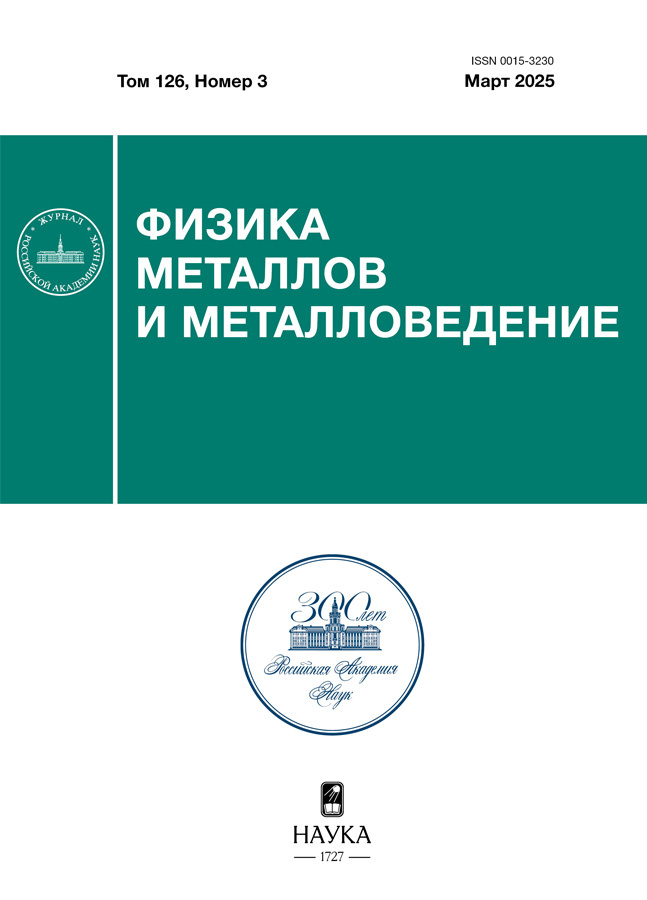Comparison between different techniques for obtaining anisotropic Nd–Fe–B hard magnetic powders by the HDDR process
- Autores: Ivanov I.A.1,2, Golubiatnikova A.A.1, Selezneva N.V.1, Protasov A.V.2, Volegov A.S.1
-
Afiliações:
- The Institute of Natural Sciences and Mathematics, Ural Federal University
- Institute of Metal Physics, Ural Branch, Russian Academy of Sciences
- Edição: Volume 126, Nº 3 (2025)
- Páginas: 279-290
- Seção: ЭЛЕКТРИЧЕСКИЕ И МАГНИТНЫЕ СВОЙСТВА
- URL: https://rjpbr.com/0015-3230/article/view/686606
- DOI: https://doi.org/10.31857/S0015323025030048
- EDN: https://elibrary.ru/IMKYSX
- ID: 686606
Citar
Texto integral
Resumo
The method for obtaining anisotropic hard magnetic Nd2Fe14B powders by the process Hydrogenation–Disproportionation–Desorption–Recombination (HDDR process) Nd–Fe–B type alloy with high content of Nd has been considered in this study. Two different types of HDDR (dynamic and solid) process have been studied. The dependence of magnetic hysteresis properties on hydrogen pressure and its pumping rate at the disproportionation stage is shown. It is found that a solid HDDR makes it possible to obtain powders with higher coercivity and the hysteresis loop rectangularity than a dynamic HDDR.
Palavras-chave
Texto integral
Sobre autores
I. Ivanov
The Institute of Natural Sciences and Mathematics, Ural Federal University; Institute of Metal Physics, Ural Branch, Russian Academy of Sciences
Autor responsável pela correspondência
Email: ilya.ivanov@urfu.ru
Rússia, Ekaterinburg, 620000; Ekaterinburg, 620108
A. Golubiatnikova
The Institute of Natural Sciences and Mathematics, Ural Federal University
Email: ilya.ivanov@urfu.ru
Rússia, Ekaterinburg, 620000
N. Selezneva
The Institute of Natural Sciences and Mathematics, Ural Federal University
Email: ilya.ivanov@urfu.ru
Rússia, Ekaterinburg, 620000
A. Protasov
Institute of Metal Physics, Ural Branch, Russian Academy of Sciences
Email: ilya.ivanov@urfu.ru
Rússia, Ekaterinburg, 620108
A. Volegov
The Institute of Natural Sciences and Mathematics, Ural Federal University
Email: ilya.ivanov@urfu.ru
Ekaterinburg, 620000
Bibliografia
- Takeshita T., Nakayama R. Magnetic properties and microstructures of the NdFeB magnet powder produced by hydrogen treatment // Proceedings of the 10th International Workshop on Ra-re-Earth Magnets and Their Applications. 1989. P. 551.
- Poenaru I., Patroi E.A., Patroi D., Iorga A., & Manta E. HDDR as advanced processing method and recycling technology to address the rare-earth resource criticality in high performance Nd2Fe14B magnets production // J. Magn. Magn. Mater. 2023. 170777.
- Habibzadeh A., Kucuker M.A., Gökelma M. Review on the Parameters of Recycling NdFeB Magnets via a Hydrogenation Process // ACS omega. 2023. 8(20). P. 17431–17445.
- Lixandru A., Poenaru I., Güth K., Gauß R., Gutfleisch O. A systematic study of HDDR processing conditions for the recycling of end-of-life Nd-Fe-B magnets // J. Alloys Compounds. 2017. 724. P. 51–61.
- Sepehri-Amin H., Dirba I., Tang X., Ohkubo T., Schrefl T., Gutfleisch O., Hono K. Development of high coercivity anisotropic Nd-Fe-B/Fe nanocomposite powder using hydrogenation disproportionation desorption recombination process // Acta Mater. 2019. V. 175. P. 276–285.
- Maltseva V.E., Andreev S.V., Neznakhin D.S., Urzhumtsev A.N., Selezneva N.V., Volegov A.S. The magnetic properties of a NdFeB permanent magnets prepared by selective laser sintering // Phys. Met. Metal. 2022. V. 123(8). P. 740–745.
- Sugimoto S., Book D. HDDR Process for the Production of High Performance Rare-Earth Magnets // Handbook of Advanced Magn. Mater. 2006. V. 1. P. 977–1007.
- Sugimoto S., Gutfleisch O., Harris I.R. Resistivity measurements on hydrogenation disproportionation desorption recombination phenomena in Nd-Fe-B alloys with Co, Ga and Zr additions // J. Аlloys Сompounds. 1997. V. 260. № 1–2. P. 284–291.
- Gutfleisch O., Harris I.R. Fundamental and practical aspects of the hydrogenation, disproportionation, desorption and recombination process // J. Phys. D: Appl. Phys. 29. V. 9. 1996. P. 2255.
- Gutfleisch O., Khlopkov K., Teresiak A., Muller K.H., Drazic G., Mishima C., Honkura Y. Memory of texture during HDDR processing of NdFeB // IEEE Тrans. Magn. 2003. V. 39(5). P. 2926–2931.
- Gutfleisch O., Matzinger M., Fidler J., Harris I.R. Characterisation of solid-HDDR processed Nd16Fe76B8 alloys by means of electron microscopy // J. Magn. Magn. Mater. 1995. V. 147(3). P. 320–330.
- Sepehri-Amin H., Ohkubo T., Hono K., Güth K., Gutfleisch O. Mechanism of the texture development in hydrogen-disproportionation–desorption-recombination (HDDR) processed Nd–Fe–B powders // Acta Mater. 2015. V. 85. P. 42–52.
- Güth K., Woodcock T.G., Schultz L., Gutfleisch O. Comparison of local and global texture in HDDR processed Nd–Fe–B magnets // Acta Mater. 2011. V. 59(5). P. 2029–2034.
- Ragg O.M., Keegan G., Nagel H., Harris I.R. The HD and HDDR processes in the production of Nd-Fe-B permanent magnets // Intern. J. Hydrogen Energy. 1997. V. 22(2–3). P. 333–342.
- Gutfleisch O., Martinez N., Verdier M., Harris I.R. Phase transformations during the disproportionation stage in the solid HDDR process in a Nd16Fe76B8 alloy // J. Alloys Сompounds. 1994. V. 215(1–2). P. 227–233.
- Cha H.R., Yu J.H., Baek Y.K., Kwon H.W., Kim Y.D., Lee J.G. The influence of dehydrogenation speed on the microstructure and magnetic properties of Nd-Fe-B magnets prepared by HDDR process // J. Magn. 2014. V. 19(1). P. 49–54.
- Mishima С., Hamada N., Mitarai H., and Honkura Y. Magnetic properties of NdFeB anisotropic magnet powder producedfme by the d-HDDR method / In Proc. 16th Int. Workshop RE Magnets and their Applications. 2000. P. 873.
- Vasilenko D.Y., Shitov A.V., Popov A.G., Gaviko V.S., Bratushev D.Y., Podkorytov K.I., Golovnya O.A. Magnetic hysteresis properties and microstructure of high-coercivity (Nd, Dy)–Fe–B magnets with Dy less than 10 wt% and low oxygen // Phys. Met. Metal. 2022. V. 123(2). P. 145–154.
- Sheridan R.S., Williams A.J., Harris I.R., Walton A. Improved HDDR processing route for production of anisotropic powder from sintered NdFeB type magnets // J. Magn. Magn. Mater. V. 350. P. 114–118.
- Wang L., Zhang M.G., Guo J.D., Zhang B.H., Xu X.H. The reaction mechanism in the hydrothermal synthesis of Nd2Fe14B magnetic particles // J. Solid State Chem. 2021. 296. P. 122003.
- Mushnikov N.V., Terent’ev P.B., and Rosenfel’d E.V. Magnetic Anisotropy of the Nd2Fe14B Сompound and Its Hydride Nd2Fe14BH4 // The Phys. Met. Metal. 2007. V. 103. N. 1. Р. 39–50.
- Mishima C., Hamada N., Mitarai H., Honkura Y. Development of a Co-free NdFeB anisotropic bonded magnet produced from the d-HDDR processed powder // IEEE Trans. Magn. 2001. V. 37. № 4. 2467–2470.
Arquivos suplementares

















